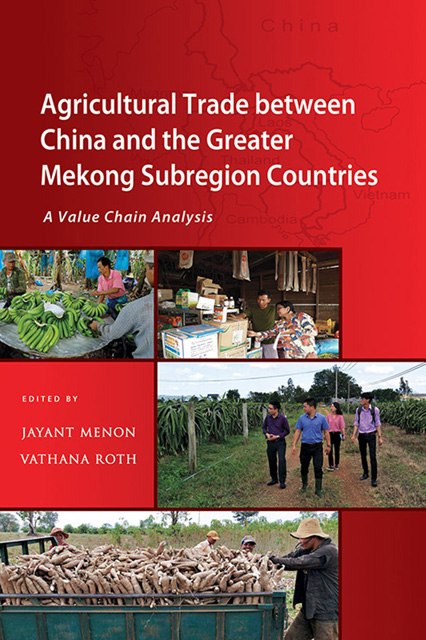Book contents
- Frontmatter
- Contents
- List of Tables
- List of Figures
- List of Annexes
- Foreword
- Preface
- Acknowledgements
- Abbreviations and Acronyms
- The Contributors
- 1 Agricultural Trade between China and the Greater Mekong Subregion Countries: An Overview
- 2 Economic Structural Change in China and the Implications for Agricultural Trade in the Lancang-Mekong Region
- 3 Agricultural Exports from Thailand to China: A Value Chain Analysis of Cassava and Durian
- 4 Agricultural Exports from Cambodia to China: A Value Chain Analysis of Cassava and Sugarcane
- 5 Agricultural Exports from Laos to China: A Value Chain Analysis of Rice and Cavendish Banana
- 6 Agricultural Exports from Myanmar to China: A Value Chain Analysis of Maize
- 7 Agricultural Exports from Vietnam to China: A Value Chain Analysis of Dragon Fruit and Coffee
- Index
Preface
Published online by Cambridge University Press: 30 June 2023
- Frontmatter
- Contents
- List of Tables
- List of Figures
- List of Annexes
- Foreword
- Preface
- Acknowledgements
- Abbreviations and Acronyms
- The Contributors
- 1 Agricultural Trade between China and the Greater Mekong Subregion Countries: An Overview
- 2 Economic Structural Change in China and the Implications for Agricultural Trade in the Lancang-Mekong Region
- 3 Agricultural Exports from Thailand to China: A Value Chain Analysis of Cassava and Durian
- 4 Agricultural Exports from Cambodia to China: A Value Chain Analysis of Cassava and Sugarcane
- 5 Agricultural Exports from Laos to China: A Value Chain Analysis of Rice and Cavendish Banana
- 6 Agricultural Exports from Myanmar to China: A Value Chain Analysis of Maize
- 7 Agricultural Exports from Vietnam to China: A Value Chain Analysis of Dragon Fruit and Coffee
- Index
Summary
The economic prospects of Southeast Asia are increasingly intertwined with that of China and the interdependency is growing with time. This is particularly true for the riparian states of the Mekong region—Cambodia, Laos, Myanmar, Vietnam and Thailand (CLMV-T). Although marketoriented reforms over the past few decades in the CLMV countries, in particular, have driven structural transformation that has involved the share of agriculture in GDP falling in favour of industry and services, it remains an important sector for several reasons.
First, the shares of agriculture in GDP do not reflect their importance as a source of employment or potential for addressing poverty, inequality or inclusion. Even in 2018, the rural sector continued to employ more than half of the labour force in Laos and Myanmar, and a third in Cambodia and Vietnam. There is also growing evidence that shows that growth driven by commercial agriculture in developing countries can have a much greater impact on poverty reduction than that coming from other sectors. Overcoming barriers that stand in the way of increased agricultural exports from the Mekong region to important and growing markets such as China can play a critical role in achieving economic and social objectives.
These developmental opportunities and possibilities provided the motivation for the study reported on in this book. The approach taken involved detailed case studies of key agricultural export commodities in the CLMV-T countries destined primarily for the Chinese market. It is only through detailed case studies that specific impediments along the value chain can be identified, as well as the non-tariff barriers (NTBs) that interfere with cross-border trade. Often these impediments and NTBs are not unique to the particular cases being studied but can manifest in other products and areas. Addressing the impediments along the value chains or the NTBs at the border can often have benefits that extend beyond the particular product or sector. These reforms can therefore produce spillover effects that can result in much larger economy-wide benefits.
There are several key takeaways for policy arising from the study. The first is that the agricultural export sector must continue to play a critical role in the development process of the Mekong region, while these countries look to industrialize through greater engagement in global value chains in manufacturing, driven by foreign direct investment.
- Type
- Chapter
- Information
- Agricultural Trade between China and the Greater Mekong Subregion CountriesA Value Chain Analysis, pp. xvii - xixPublisher: ISEAS–Yusof Ishak InstitutePrint publication year: 2022

